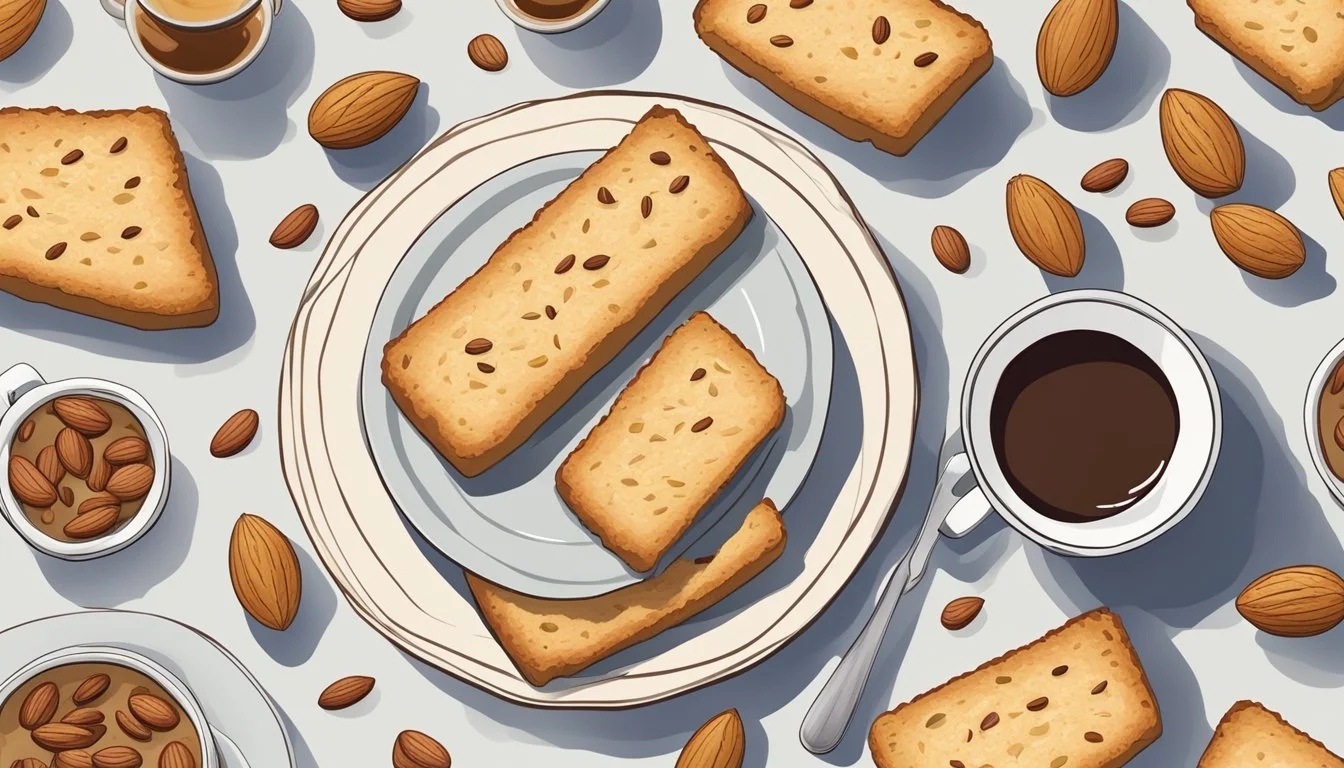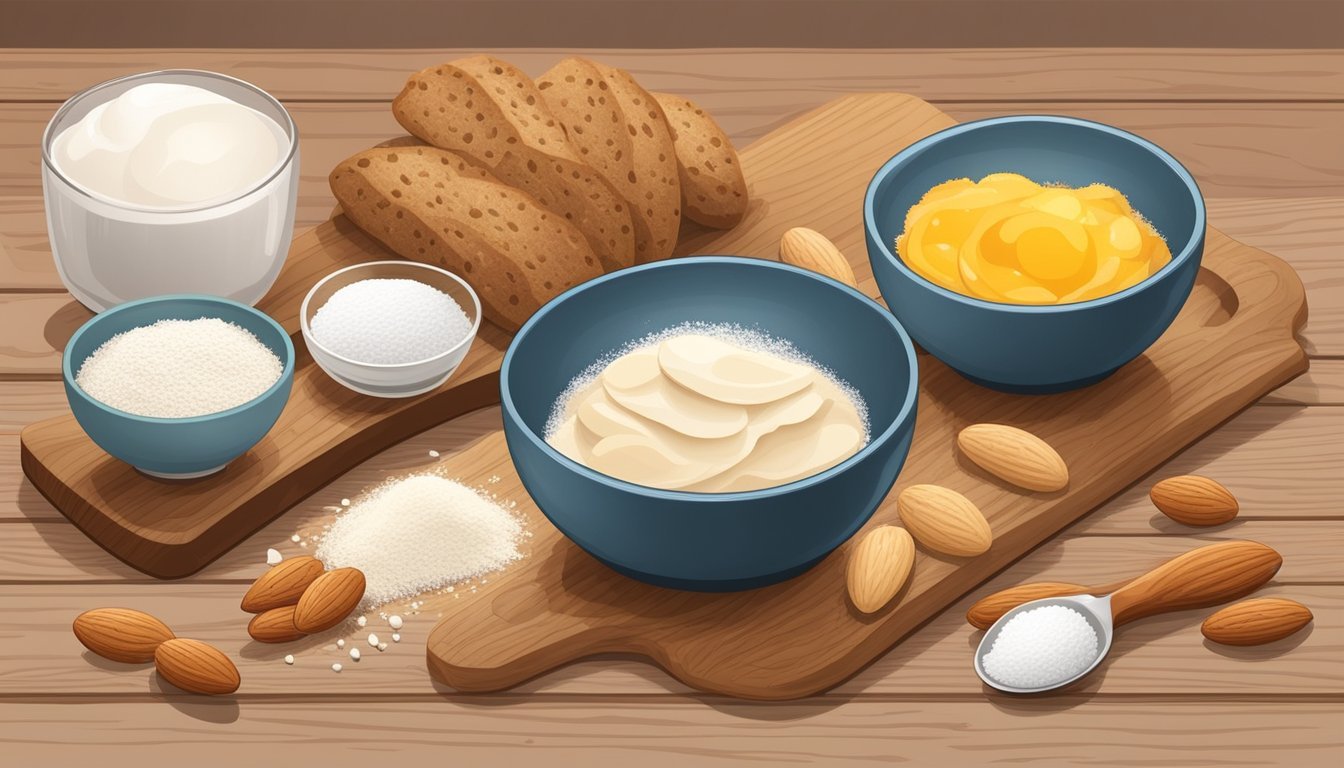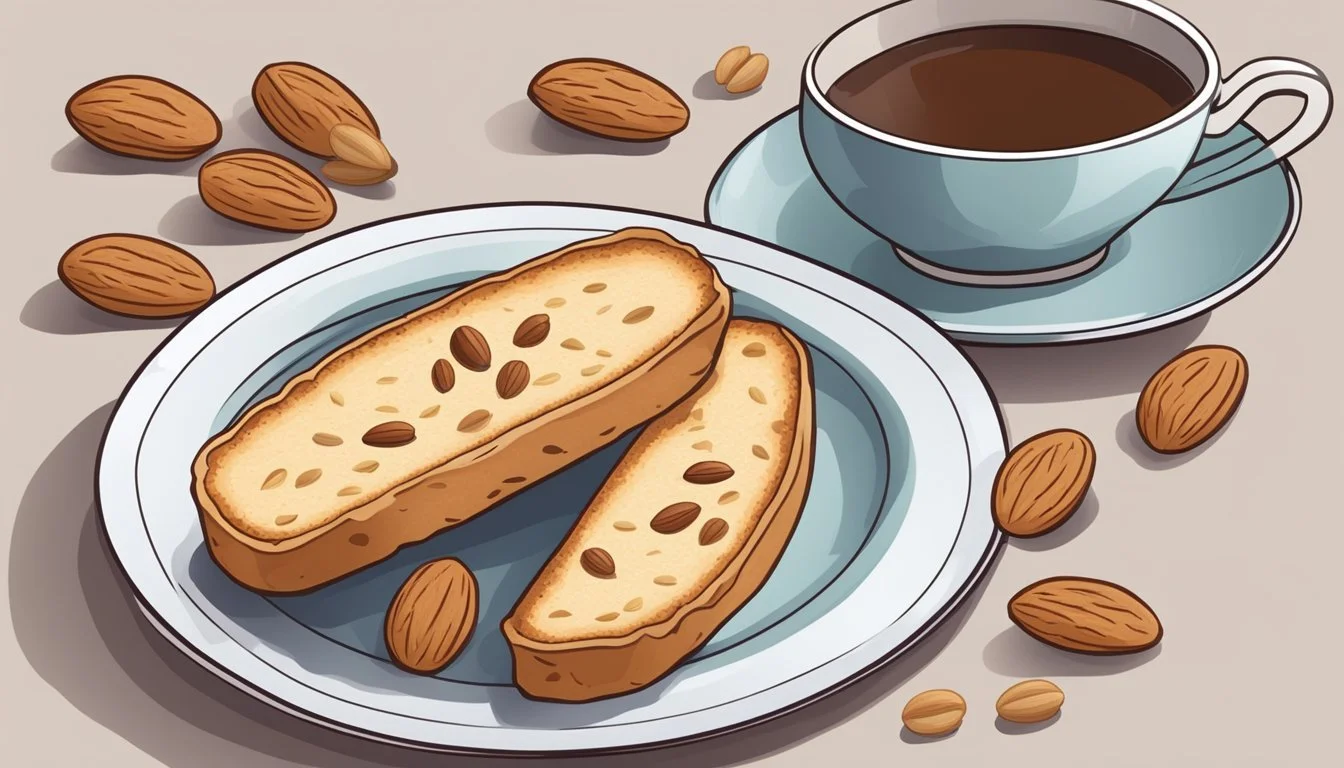How Do You Eat an Almond Biscotti?
Mastering the Art of Savoring This Italian Treat
Almond biscotti, a traditional Italian dessert, is a treat that is both simple to enjoy and steeped in rich culinary tradition. Originating from the Italian word "biscotto," meaning "twice-cooked," this crunchy, almond-studded cookie has been savored for centuries. The distinct texture of biscotti is achieved through a unique baking process where the dough is first shaped into a log and baked, then sliced into individual cookies and baked again until they reach a perfect crispness.
The beauty of almond biscotti lies not only in their satisfying crunch but also in their versatility. These cookies are often dipped into a variety of beverages, from morning coffee to sweet dessert wines, which softens their texture and enhances their flavor. The addition of almonds not only provides a nutty taste but also a pleasant contrast to the biscotti's crunchy texture. While modern variations may include ingredients like chocolate chips or dried fruits (What wine goes well with dried fruits?), the classic almond version remains a timeless favorite.
Eating almond biscotti is a straightforward pleasure. They can be savored slowly, bite by crispy bite, or dipped into a favorite drink for an added dimension of flavor and texture. Whether enjoyed as a mid-morning snack or a complement to an after-dinner espresso, almond biscotti offer a flavorful experience that connects the present to the time-honored baking traditions of Italy.
Understanding Biscotti
This section delves into the rich tapestry of history behind almond biscotti and pinpoints what sets these twice-baked cookies apart in the realm of Italian desserts.
Origins and History
Biscotti trace their origins back to the region of Tuscany in Italy. The word "biscotti" originates from the Latin "biscoctus," meaning "twice-cooked," which is an accurate representation of its unique baking process. Historically favored for their long shelf life during long journeys and wars, these crunchy cookies were once a staple for Roman legions.
What Makes Biscotti Unique
Italian biscotti, also known as cantucci, are distinguished by their twice-baked method, a defining feature that ensures their signature crunchy texture. The process involves initially shaping the dough into a log, baking it, and then slicing it into individual cookies for a second bake. This dual-baking removes moisture, resulting in a traditionally dry consistency ideal for dipping into beverages like coffee or wine.
Almond Biscotti Ingredients
Creating the perfect almond biscotti requires a selection of ingredients that are divided into primary components for structure, flavor enhancers that give it its distinctive taste, and optional add-ins for additional texture and depth.
Primary Ingredients
All-purpose flour: The fundamental building block for biscotti, providing the necessary structure.
Sugar: Sweetness to balance the nutty flavor of almonds.
Eggs: Bind the dough and help it rise slightly during baking.
Baking powder: A leavening agent that creates a light texture within the biscotti.
Salt: Accentuates flavors and adds balance.
Flavor Enhancers
Almonds: A key ingredient, they're often toasted to enhance their nutty flavor.
Almond extract: Amplifies the almond flavor within the biscotti.
Vanilla extract: Adds a warm, complex sweetness.
Butter: Contributes to the richness and delicate crumb.
Lemon zest or Orange zest: These citrus zests can be added for a bright, slightly tart contrast to the sweet almond flavor.
Optional Add-ins
Chocolate chips: For a sweet, decadent twist.
Dried fruits: Ingredients like cranberries or apricots introduce a chewy texture and tartness.
Nuts: Pecans, walnuts, or pine nuts for additional crunch and flavor variations.
Additional flavors: Ingredients like anise, cinnamon, or cardamom can be included to create unique variations on the classic biscotti.
Preparing to Bake
In baking almond biscotti, the two critical initial steps involve creating a cohesive dough and shaping it into logs which will later be sliced into the iconic biscotti shape.
Creating the Dough
To begin crafting the biscotti recipe, one starts by assembling the dry ingredients into a mixing bowl. It is important to thoroughly combine ingredients like flour, sugar, baking powder, and salt to ensure an even distribution. Typically, the butter and sugar are beaten together until light and fluffy, which incorporates air and aids in the rise of the biscotti. Once this texture is achieved, eggs and almond extract are added, providing moisture and flavor. Care must be taken to mix just until the dough comes together to avoid overworking it.
Shaping the Logs
With the dough ready, bakers shape it with their hands into one or multiple log shapes, depending on the recipe's specifications. The dough should rest on a baking sheet lined with parchment paper to prevent sticking and to allow for easy transfer after the initial bake. The goal is to achieve a uniform log shape with even thickness to ensure consistent baking and easy slicing later on. The size of the logs typically ranges, but a common dimension is approximately 12x2 inches. Adjustments can be made based on the desired size of the finished biscotti. Once shaped, the logs are ready for the first bake, which will set their form before they are sliced and baked again to achieve a crisp texture.
Baking Process
The baking process for almond biscotti involves two distinct stages, ensuring the cookies achieve their signature crispy texture.
First Bake
Preheat the oven—the initial temperature is often set to 350°F (175°C). The almond biscotti dough is shaped into logs, usually about 1/2 to 3/4 inch in height, and placed on a baking sheet. It's important to shape them evenly so they cook uniformly. The logs are then baked until they are golden and firm to the touch. This first bake typically lasts between 25 to 35 minutes, but times may vary based on oven and log size. After baking, they are cooled on a wire rack for a short time.
Second Bake
Once the baked logs are cool enough to handle, but still warm, they are transferred to a cutting board. Using a serrated knife, the baker slices the logs on a diagonal into long, thin pieces. These slices are then arranged back onto the baking sheet, often placed on their sides, and returned to the oven. This second bake is at a lower temperature, often around 325°F (163°C), and aims to dry out the biscotti further, giving them their characteristic dry and crisp texture. The cook time for this stage varies, but it is usually around 10 to 15 minutes per side until they turn a light golden shade.
Serving and Pairing
Almond biscotti are versatile treats that can be savored in various ways, from a casual snack to a refined dessert complement. They are enjoyed for their distinct texture that pairs exceptionally well with an array of beverages.
How to Serve Biscotti
Almond biscotti can be served as a standalone snack or dessert. They are often presented alongside other desserts on a platter. For individual servings, placing two or three biscotti on a small plate is customary. Dunking biscotti in a preferred beverage enhances their flavor and softens their crunchy texture, making them easier to chew.
Pairing with Beverages
The traditional Italian method involves dipping biscotti in a sweet dessert wine, such as Vin Santo. However, biscotti can be paired with a variety of other beverages:
Espresso or coffee: Biscotti's robust texture withstands dunking, and its sweet almond flavor complements the bitter notes of coffee.
Tea: A gentler option, tea can range from black to herbal, adding a warm, soothing element to the biscotti experience.
Hot Chocolate: For a sweet treat, dunking biscotti in hot chocolate adds a creamy texture and chocolatey taste.
Milk: A glass of milk with biscotti is a classic combination, particularly favored by children and those preferring a milder pairing.
Storing and Preservation
When it comes to almond biscotti, appropriate storage is key to preserving both their freshness and delightful crunch. The shelf life of biscotti greatly hinges on the methods used to store and preserve them. Here are the ways to ensure your biscotti remain as fresh as the day they were baked.
Keeping Biscotti Fresh
To keep biscotti fresh, it is vital to store them in an airtight container at room temperature. This method helps maintain their crispness by limiting exposure to moisture and air. Placing a paper towel inside the container can aid in absorbing any excess moisture that may accumulate. Here’s a concise table summarizing the rule of thumb for room temperature storage:
Storage Method Shelf Life Additional Note Airtight Container Up to 1 month Store in a cool, dry place away from direct sunlight.
Freezing for Long-Term
For long-term preservation, freezing biscotti is an efficient approach. To freeze, first ensure the biscotti are completely cool to prevent condensation. Then, store them in a freezer-safe airtight container or a heavy-duty freezer bag. For extra protection, you may separate layers of biscotti with parchment paper to prevent them from sticking together.
Storage Method Shelf Life Additional Note Freezer (airtight) Up to 3 months Use parchment paper between layers to avoid sticking.
By following these storage guidelines, one can prolong the delectable taste and texture of almond biscotti for future enjoyment.
Biscotti Variations
Biscotti, the twice-baked Italian cookies known for their crunchy texture, can be customized with various flavors and ingredients to cater to a wide array of palates and dietary needs.
Alternative Flavors
Traditional Italian almond biscotti often include whole or slivered almonds, enriching the cookies with a nutty crunch. Beyond classic almond, bakers can introduce a plethora of flavors to their biscotti. Chocolate chunks or cocoa powder can be added for chocolate biscotti, blending beautifully with the almonds. Dried fruits like cranberries or cherries offer a tangy contrast to the sweetness, while spices such as cinnamon or nutmeg introduce warmth. For a different take, bakers might incorporate lemon or orange zest for a citrusy twist. Here is a list highlighting a selection of alternative ingredients:
Nuts: pistachios, hazelnuts, pecans
Chocolate: dark, milk, or white chocolate chips; cocoa powder
Fruit: dried cranberries, apricots, or figs
Citrus: lemon or orange zest
Spices: anise, cinnamon, or cardamom
Nut-Free and Gluten-Free Options
For those with dietary restrictions, there are variations that can accommodate their needs without sacrificing flavor. Nut-free biscotti might utilize seeds, such as sunflower or pumpkin, as substitutions for almonds and other nuts, offering a similar crunch. Gluten-free biscotti are achievable by using gluten-free flour blends designed to mimic the properties of wheat flour. In both cases, it is critical to ensure that all other ingredients, including mix-ins and flavorings, meet the dietary requirements. Below are suggested replacements for common biscotti ingredients:
Nut replacements: sunflower seeds, pumpkin seeds, sesame seeds
Gluten-free flour: rice, almond, or oat flour (certified gluten-free)
By integrating these alternatives, bakers can produce biscotti that not only maintain the cookie's distinctive texture but also provide an inclusive array of flavors for people with specific dietary preferences or restrictions.
Nutritional Profile
Almond biscotti are enjoyed for their delightful taste and satisfying crunch. Their nutritional content is marked by a moderate caloric value and the health benefits that come from almonds, such as healthy fats and protein.
Caloric Content
For a typical serving size of almond biscotti, which varies between 22 grams and 28 grams, the calorie count can range from approximately 80 to 130 calories. The exact number depends on specific recipe variations and ingredient proportions. Below is a simplified breakdown of calorie distribution in an average almond biscotti serving:
One 22g serving of almond biscotti: 80 calories
Calories from fat: 18 calories (22.5%)
One 28g serving of traditional Italian almond biscotti: 130 calories
Calories from fat: 40.5 calories (31.2%)
Health Benefits
Almond biscotti incorporate whole almonds and almond extract, both of which contribute nutritional value aside from taste. Almonds offer:
Healthy fats: A source of unsaturated fats that promote heart health.
Protein: Essential for bodily repair and muscle maintenance.
Fiber: Beneficial for digestive health.
Given the presence of almonds in biscotti, they are a source of nutrition that could fit into a balanced diet. However, it is essential to remember healthy options vary for individuals, and moderation is key, especially in foods with added sugars.
Making Biscotti at Home
Creating biscotti at home can be a rewarding process that yields delightful, crisp treats perfect for dunking. The key to excellent homemade biscotti lies in precise baking and adhering to a few critical steps that ensure the perfect texture.
Step-by-Step Guide
Prep the Ingredients: They should gather all required ingredients which typically include flour, sugar, eggs, baking powder, and flavorings like almond extract. Some recipes may include butter for a richer texture.
Mixing the Dough: Begin by mixing the dry ingredients such as flour, baking powder, and salt. In a separate bowl, they should cream together butter and sugar until light and fluffy, then incorporate the eggs and almond extract.
Shaping the Dough: The dough should then be divided into logs and placed on a baking sheet lined with parchment paper.
First Bake: They should bake the logs until they are just golden brown, ensuring that they are firm to the touch but not too hard.
Slicing: After a short cooling period, they should slice the logs diagonally to create the traditional biscotti shape.
Second Bake: The slices are baked again to achieve their characteristic dry and crunchy texture.
Tips for Perfect Biscotti
Toasting Nuts: If they're adding almonds, toasting them first can enhance the flavor.
Even Slicing: For uniform cooking and appearance, they should slice the biscotti evenly, aiming for about a half-inch thickness.
Watch the Color: They should look for a golden-brown color as an indicator of doneness, but they must take care not to overbake which can result in overly hard biscotti.
Cooling Time: Allowing the biscotti to cool properly between the first and second bakes helps with easier slicing and better texture.
Storing: Once completely cooled, biscotti can be stored in an airtight container to maintain their crispness.








